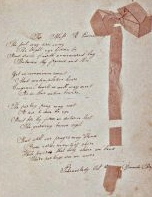As part of our "Remembering Ribbons" series, we are showcasing the ways in which they were used during the Victorian Era. Although one might consider them a mere fashion accessory, we shall soon see that there is important symbolism behind them as well.
 |
| The Shop Girl (The Vendor of Ribbons) by James Tissot |
The Victorian Era would be the last to patronize ribbons to such a large degree. Their decline would soon be known in the following centuries as feminists began to streamline clothing, eventually making the wardrobe more masculine and fitting for the work force (and therefore removing women from the home).
 |
| The Blue Ribbon by Alfred Stevens |
Ribbons were sewn onto dresses, attached to hats and woven through hair. Scarcely a Victorian story could be written without addressing how the ribbon was worn by the female characters. In many a novel, it's extravagant or simple use hinted to the reader about the nature (or financial position) of its wearer...

"But the bonnet was made of solid straw, and its only trimming was a plain white ribbon put over the crown, and forming the strings."
~ Elizabeth Gaskell, Wives and Daughters
"Her dress was very plain: a close straw bonnet of the best material and shape, trimmed with white ribbon; a dark silk gown, without any trimming or flounce; a large Indian shawl, which hung about her in long heavy folds, and which she wore as an empress wears her drapery."
~ Elizabeth Gaskell, North and South
The Yellow Ribbon by Albert Tayler, 1889
|
The simplest of clothing became special with the addition of a ribbon. However, they were not limited to adornment of only skirts, blouses and hair.
| 1928 Cameo Ribbon Necklace |
Ribbons were also worn as a necklace. Although Queen Elizabeth and Catherine the Great had a vast collection of these, it was Queen Victoria who revived this style by wearing black velvet ribbons to display her lovely cameos. They were tied closely around the neck and referred to as "chokers".
Ribbons were also used to embellish letters (authentic example shown above) and to keep them bundled together for a sweet storage. Perhaps the ideas for modern day scrap-booking come from the ingenuity of our Victorian ancestors who loved to add beauty to ordinary things.
Ribbons were also used to embellish letters (authentic example shown above) and to keep them bundled together for a sweet storage. Perhaps the ideas for modern day scrap-booking come from the ingenuity of our Victorian ancestors who loved to add beauty to ordinary things.
 |
| Red Ribbon Heart Lariat Charm Necklace |
During this time period, the red ribbon was used as a symbol of temperance (more specifically, it meant for people to completely abstain from all intoxicating beverages and to solidify this promise by "taking the pledge") ...
"The Red Ribbon is all the go;
It's the temperance sign, you know;
It is seen wherever you go,
On men who dare do right.
Three cheers for all red ribbon men,
And also those that is their friend;
God will be with you to the end,
He's ever on the right."
~ Excerpts from the poem, "The Red Ribbon" by Julia A Moore
| Old Logo of the Woman's Christian Temperance Union, Est. 1873 |
In our modern day society, the red ribbon is no longer associated with complete abstinence of alcohol but is used as a symbol to be "drug free" and warn "against drunk driving" (which is taught in the public school system during their "Red Ribbon Week"). May our lovely readers keep all three meanings close to their hearts in honor of Proverbs 20:1! Perhaps a red ribbon can still remind one of this promise?
| Rose Ribbon Embroidery Pendant Kit |
Lastly, to encourage a spirit of femininity and give a nod to Victorian Era ribbons... A beautiful way to blend the past with the present can be found in these rose-ribbon embroidery pendant kits. You can learn a new skill (rose ribbon embroidery) while creating these antique style necklaces which would also make lovely gifts.
















